Solved Examples and Worksheet for Comparing Properties of Two Functions
| X | Y |
| 0 | 30 |
| 1 | 27 |
| 2 | 24 |
| 3 | 21 |
| 4 | 18 |
ii.) The function whose input and output are related by
A. (i)
B. Neither (i) nor (ii)
C. (ii)
D. Both (i) and (ii)
Step: 1
From function1, Mary has $30 and spends money each week. The amount of money left from her and $3 decreases each week.
Step: 2
So, the graph has a negative slope of -3.
Step: 3
From function 2, y x y mx + c
Step: 4
Function 1 has a negative slope.
Correct Answer is : (i)
(i) The school book store rents graphing calculators for $4 per month. It also collects a non- refundable fee of $5 for the school year. The total cost y of renting a calculator is modeled by function 1 where x denotes the number of months.
(ii) The graph of function 2 is as shown.
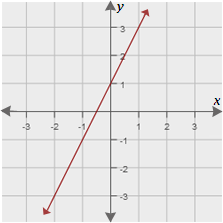
A. Both functions have equal rate of change
B. Function 1
C. Function 2
Step: 1
The graph of function 2 contains (0, 1) and (1, 3).
[From graph]
Step: 2
So, slope of the graph that represents function 2 = 3 - 1 1 - 0 2 1
[m y 2 - y 1 x 2 - x 1
Step: 3
So, the rate of change of function 2 is 2.
Step: 4
From the description of function 1, it can be represented as y x y x
Step: 5
So, the rate of change of function 1 is 4.
Step: 6
Therefore, function 1 has greater rate of change.
[4 > 2]
Correct Answer is : Function 1
(i) Function 1 is represented by the table shown.
| 1 | 2 | 3 | 4 | 5 | |
| 3 | 4 | 5 | 6 | 7 |
(ii)The graph of function 2 is a shown.
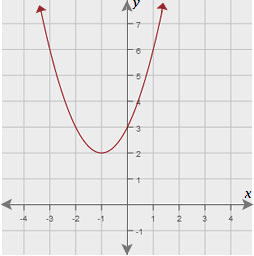
A. Both functions
B. Function 2
C. Function 1
Step: 1
Linear equation in intercept form is y a + bx b a y
Step: 2
From the table, change in output values = 1
Step: 3
Change in input values = 1
Step: 4
Rate of change = C h a n g e i n o u t p u t v a l u e s C h a n g e i n i n p u t v a l u e s 1 1
Step: 5
Working backwards with the values in the table, we get (0, 2). So, the y
Step: 6
So, the function 1 that satisfies the table is y x
Step: 7
Correct Answer is : Function 1
(i) Josh counted that the number of students who participated in different sports are 2, 4, 6, 8, and 10 respectively. The situation is modeled by function 1 as
(ii)The graph of function 2 is as shown.
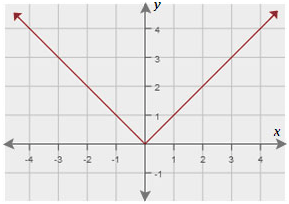
A. Function 1
B. Function 2
C. Both functions
Step: 1
A function such that f x f - x
Step: 2
If we observe the given functions 1 and 2, we will notice that Function 2 is an even function.
Correct Answer is : Function 2
(i) Wilma had $8 with her. She sold x cards at $4 each and earned some money. The money she had with her finally is modeled by function 1 is
(ii) Function 2 is given by
A. Both functions
B. Function 2
C. Function 1
Step: 1
Linear equation in intercept form is y = a + bx b a y
Step: 2
Function 1 is given by y x
Step: 3
The function 2, y x
[Nonlinear functions are functions that do not have constant rate of change.]
Step: 4
So, function 1 has a constant rate of change.
Correct Answer is : Function 1
(i) Function 1 is represented by the table that shows the relationship between time and volume for a tank that is filling with water.
| Time | 1 | 2 | 3 | 4 | 5 |
| Volume | 4 | 8 | 12 | 16 | 20 |
(ii) Function 2 is given by
A. Function 2
B. Both functions
C. Function 1
Step: 1
Linear equation in intercept form is y = a + bx b a y
Step: 2
From the table, change in output values = 4
Step: 3
Change in input values = 1
Step: 4
Rate of change = C h a n g e i n o u t p u t v a l u e s c h a n g e i n i n p u t v a l u e s 4 1
Step: 5
Working backwards with the values in the table, we get (0, 0). So, the y
Step: 6
So, the function 1 that satisfies the table is y x
Step: 7
Function 2 is given by y x y = a + bx
Step: 8
If the graph of a function has positive slope, then that function is said to be an increasing function.
Step: 9
Slope of function 1 is 4(>0). So it is an increasing function.
Step: 10
Slope of function 2 is -2(<0). So it is not an increasing function.
Correct Answer is : Function 1
(i) Function 1 is represented by the table that shows the relationship between the age of a mother and her child on her child's birthday.
| Child's age | 1 | 2 | 3 | 4 | 5 |
| Mothers age | 23 | 24 | 25 | 26 | 27 |
(ii) The graph of function 2 is as shown.
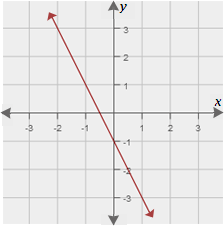
A. Function 1
B. Function 2
C. Both functions
Step: 1
Linear equation in intercept form is y = a + bx b a y
Step: 2
From the table, change in output values = 1
Step: 3
Change in input values = 1
Step: 4
Rate of change = C h a n g e i n o u t p u t v a l u e s C h a n g e i n i n p u t v a l u e s 1 1
Step: 5
Working backwards with the values in the table, we get (0, 22). So, the y
Step: 6
So, the function 1 that satisfies the table is y x
Step: 7
The graph of function 2 contains (0, -1) and (-1, 1).
[From graph]
Step: 8
So, slope of the graph that represents function 2 = 1 - ( - 1 ) - 1 - 0 2 - 1
[m y 2 - y 1 x 2 - x 1
Step: 9
The graph of function 2 contains (0, -1). So, the y
[y y x
Step: 10
So, the function 2 that satisfies the graph is y x
Step: 11
If the graph of a function has positive slope, then that function is said to be an increasing function.
Step: 12
Slope of function 1 is 1(>0). So it is an increasing function.
Step: 13
Slope of function 2 is -2(<0). So it is a decreasing function.
Correct Answer is : Function 2
(i) Function 1 is given by
(ii) The graph of function 2 is as shown.
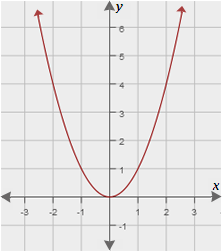
A. Both functions
B. Function 1
C. Function 2
Step: 1
The graph of function 2 contains (-2, 4), (-1, 1), (0, 0), (1, 1) and (2, 4).
[From graph]
Step: 2
From these points, it can be observed that y x
[4 = (-2)2 = (2)2; 1 = (-1)2 = (1)2]
Step: 3
So, the function 2 that satisfies the graph is y x
Step: 4
A function y f x f -x -f(x x f
Step: 5
Function 1 is given by y f x x
Step: 6
For function 1, f -x -x x f x
Step: 7
So, function 1 is an odd function.
[f -x f x
Step: 8
For function 2, f -x -x x f x
Step: 9
So, function 2 is an even function.
[f -x f x
Correct Answer is : Function 1
(i). The table shows the values of a function
| X | Y |
| -1 | 1 |
| 0 | 0 |
| 1 | -1 |
| 2 | -2 |
| 3 | -3 |
Where
A. Neither i nor ii
B. i
C. ii
D. Both i and ii
Step: 1
From the function y [x]
Correct Answer is : i
- Determining a given Relation is a Function-Algebra1-Solved Examples
- Finding Values of a Function for a given Domain-Algebra1-Solved Examples
- Graphing Linear Functions for a Given Domain-Algebra1-Solved Examples
- Graphing Linear Functions-Algebra1-Solved Examples
- Finding the Rate of Change-Algebra1-Solved Examples
- Finding Intercepts of a Linear Equation-Algebra1-Solved Examples
- Graphing Piecewise and Step Functions-Algebra1-Solved Examples
- Graphing Absolute Value Functions-Algebra1-Solved Examples
- Finding Intercepts of Quadratic Functions-Algebra1-Solved Examples
- Graphing and Analyzing Quadratic Functions-Algebra1-Solved Examples
- Identifying and Graphing Square Root Functions-Algebra1-Solved Examples
- Finding Intervals for Increasing and Decreasing Functions-Algebra1-Solved Examples
- Representing Exponential Functions Using Tables or Graphs-Algebra1-Solved Examples
- Graphing Logarithmic Functions-Algebra1-Solved Examples
- Graphing Trigonometric Functions-Algebra1-Solved Examples
- Identifying and Using Recursive Formula-Algebra1-Solved Examples
Related Worksheet
- Function